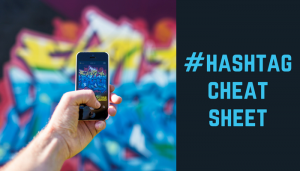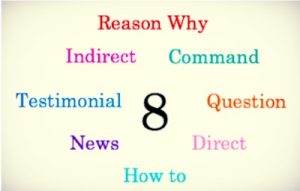Month: November 2017
Hashtag Cheat Sheet
If you spend time on Facebook, Instagram, Twitter or other social media sites, you’ve likely seen the “#” symbol used in a post or tweet. Known as a hashtag, this symbol is actually a powerful tool that can help you extend your marketing reach and increase engagement with your audience.
Yet I’ve discovered that many of my clients and colleagues don’t know much about them. If you fall into this category and you want to learn more about how you can use hashtags in your marketing, this “hashtag cheat sheet” is for you.
What is a hashtag?
• A label for categorizing content on social media
What are hashtags used for?
• Lets you engage with social media users to discuss a common theme or interest
• Allows others to easily find your content
• Helps you find relevant content on a topic when you search using a hashtag
• In the case of big events, a hashtag lets people to share their opinions and sentiments
• Can be used to market your business content
What’s in a hashtag?
• Must begin with # symbol
• Can be a single word, entire phrase, abbreviation, or combo of letters and numbers
• Cannot use all numbers – must be combo of numbers and at least 1 letter
• No spaces – all characters must run together (example: #ReadyForTheWeekend)
• No punctuation, other than the hashtag at the beginning
How do I create a hashtag?
• Just think it up and start using it in your messages
• For hashtag ideas or to see what’s trending, check out Hashtagify.me, RiteTag, Sprout Social
• Hashtags can be added anywhere in your message, but usually at the end
• Hashtags do not need to be registered – just create and use
Hashtag Do’s and Don’ts
• Keep it short, understandable and easy to remember
• Be specific – this helps you target a certain audience
• Don’t overuse – only 1-2 hashtags per message
• Don’t add a hashtag to an unrelated message just to get attention for your content – you could be flagged as a spammer
• Understand the various ways hashtags are used on different social media platforms
• Note: Google+ automatically adds a hashtag to your content – can switch to manual mode if you want to select your own
Is it okay to use an existing hashtag?
• If joining an ongoing discussion, it’s okay to use a hashtag currently in use – simply add it to the end of your social media update
• If starting a new discussion, it’s best to come up with your own – otherwise, it can be confusing or seen as trying to hijack another discussion to gain attention
• Don’t use hashtag if same or similar to a user name – could be seen as trademark violation or attempt to hijack that person’s brand and may result in cease-and-desist letter
• Okay to use generic hashtags like #Marketing or #Sales
Where to use a hashtag?
• On numerous social media platforms – Facebook, Instagram, Twitter, Google+, etc.
• In your marketing messaging to identify content, videos, photos, events, contests and more
How can hashtags be used with small businesses?
• Hold a contest – get people to enter your contest by using a hashtag
• Network with others – use #FollowFriday or #FF to call out helpful content on Twitter
• Conduct a Twitter chat – a hashtag helps you easily follow tweets in a particular chat
• Connect with conference attendees – most conferences use hashtags to promote their event; you can use it to see who is attending, then connect with individuals separately
• Share business content using generic hashtags – to find business content, search for specific hashtags like #Marketing; to share your content, use generic hashtags within your content
• Hashtags can also help you: find better conversations, join a chat, conduct research, locate a specific group online, scout the competition
Now that you know what #hashtags are and how they can help you connect with your audience, get out there and start using them!
A Gram of Grammar: Parallel Construction
When we speak or write, our brains process words quicker if they are uniform in structure. Using parallel construction makes understanding the content much easier. Let’s take a look at how this works.
Read this sentence out loud:
A successful meeting requires a prepared agenda, to discuss key topics and agreeing on next steps.
A little awkward, right? Was it difficult to follow what was being communicated?
That’s because there are three different grammatical structures. “Agenda” is a noun, “to discuss” is an infinitive and “agreeing” is a participle.
Now let’s rework it a bit and try again:
A successful meeting requires following a prepared agenda, discussing key topics and agreeing on next steps.
Easier to follow, isn’t it? Now each item in the list—following, discussing, agreeing—is a participle and the grammatical structure matches up.
Every time you write or speak, remember to use parallel construction so you can keep your words in line. If you do, you’ll have greater success getting your message across.
8 Headline Types You Need to Know
Do you ever struggle to write compelling headlines? Ones that will grab attention, pull in prospects and get them to read on? If so, you’re not alone.
Many of us—yes, even writers like me—get stuck from time to time. Luckily, there’s a way to get unstuck.
The list below outlines eight basic headline types that have been used to sell all kinds of products and services in countless industries. Use them to engage your audience and get your message across.
#1 – Direct Headline
This is a “tell it like it is” headline. No gimmicks, no clever wordplay, no hidden meanings. Just the facts.
Example: College Recruiting Tips for Players and Coaches
#2 – Indirect Headline
With this type of headline, you don’t directly state your point. Instead, you hint at it. This raises questions and arouses curiosity … compelling your customer to read further.
Example: Take Your Office to the Cloud
#3 – News Headline
This headline works well if you have an announcement to make about your company or products.
Example: Mars India Chooses Solatube for Sustainable Lighting Solution
#4 – How to Headline
Your customers are looking for a solution to a problem. This headline tells them clearly that you have the solution.
Example: How to Improve Solo Blocking
#5 – Question Headline
If a question is asked, it’s ingrained in us to respond. Use this headline to engage your customers. Just be sure the question focuses on your customer’s needs, wants and desires … not your company’s.
Example: Are You Living the Life You Deserve?
#6 – Command Headline
Sometimes telling your customer what to do is the best strategy. Use strong verbs for maximum impact.
Example: Elevate Your Game with Real Technology
#7 – Reason Why Headline
This popular header type alerts customers that they’re about to read a “list” article. Often, the list ties to a product’s features and benefits. This approach makes writing body copy relatively easy.
Example: 5 Reasons Your Mancave Needs Daylight
#8 – Testimonial Headline
Testimonials work because a satisfied customer is doing the selling, not you. It offers objective proof that your product works. Use the customer’s actual wording to make it believable.
Example: “It Shoots Into the Air Like a Cannon …”
With these eight header types in your content development tool belt, you’ll be able to write effective headlines that get attention, drive your audience to take action, and make the sale.
A Gram of Grammar: Less vs. Fewer
Do you know when to use “less” versus “fewer”?
Since their meanings are similar, it can be tricky. Here’s a simple way to help you remember.
“Less” is used with mass nouns or nouns that deal with a volume or an amount of something.
Less Example: We have less time to finish the project than last time.
“Fewer” is used with counting nouns. In other words, if something can be counted, use fewer.
Fewer Example: Fewer people attended the meeting than last week.




